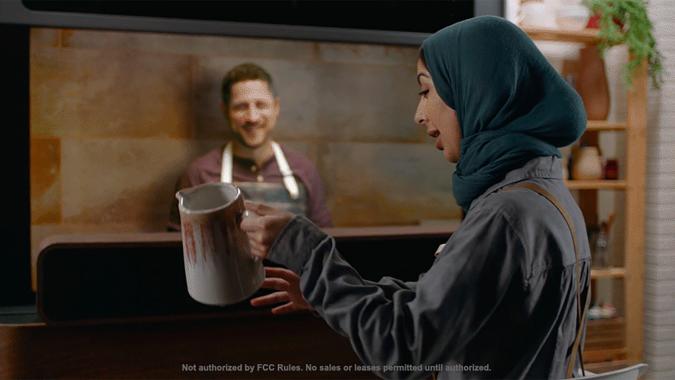
Image Credit: BI Virgin Orbit, a rocket busines...
news-extra-space

 The video booth's display side includes 14 cameras and 16 infrared projectors, all of which work together to create, capture, and track a real-time, photorealistic 3D avatar of the user. Four microphones and two speakers do more than just play back speech; spatialized audio and dynamic beamforming are said to make it sound like it's coming from the avatar's mouth.
Sending a 3D avatar over the video chat connection enables Google to correct for eyeline, which is a persistent issue with standard video chat. A 3D avatar can fudge the disconnect between the center of a camera and the center of a display, allowing for mutual eye contact where a webcam on top of a display makes it impossible to make eye contact while looking at a display. All of this data is being crunched by Google in a beefy dual-Xeon workstation outfitted with "four NVIDIA GPUs; two Quadro RTX 6000 and two Titan RTX."
The video booth's display side includes 14 cameras and 16 infrared projectors, all of which work together to create, capture, and track a real-time, photorealistic 3D avatar of the user. Four microphones and two speakers do more than just play back speech; spatialized audio and dynamic beamforming are said to make it sound like it's coming from the avatar's mouth.
Sending a 3D avatar over the video chat connection enables Google to correct for eyeline, which is a persistent issue with standard video chat. A 3D avatar can fudge the disconnect between the center of a camera and the center of a display, allowing for mutual eye contact where a webcam on top of a display makes it impossible to make eye contact while looking at a display. All of this data is being crunched by Google in a beefy dual-Xeon workstation outfitted with "four NVIDIA GPUs; two Quadro RTX 6000 and two Titan RTX."
 The display is a 65-inch, 8 K, 60 Hz autostereoscopic lenticular panel that generates a 3D view of a life-size avatar without the use of glasses. It's essentially a larger Nintendo 3DS with a larger sweet spot thanks to head tracking. The opposite side of the booth has an infrared backlight and a rather rigid-looking bench that confines the user to the display's 3D sweet spot and limits the scope of the entire avatar-generation system. Google even constructed a small barrier between the bench and the display to conceal the display's bottom.
Instead of having an avatar end awkwardly when you reach the bottom of the screen, a physical occlusion over the bottom of the display allegedly tricks your brain into thinking the rest of the avatar exists behind the barrier. Google appears to be committed to controlling every possible variable with Project Starline, to the point where the booth has its own lighting system, with both diffuse visible lighting to aid in 3D texture capture and a large infrared backlight to aid in 3D imaging.
A Google statement says: "Today, Project Starline prototypes are found in Google offices across the US, with employees using the technology every day for meetings, employee onboarding and building rapport between colleagues."
The display is a 65-inch, 8 K, 60 Hz autostereoscopic lenticular panel that generates a 3D view of a life-size avatar without the use of glasses. It's essentially a larger Nintendo 3DS with a larger sweet spot thanks to head tracking. The opposite side of the booth has an infrared backlight and a rather rigid-looking bench that confines the user to the display's 3D sweet spot and limits the scope of the entire avatar-generation system. Google even constructed a small barrier between the bench and the display to conceal the display's bottom.
Instead of having an avatar end awkwardly when you reach the bottom of the screen, a physical occlusion over the bottom of the display allegedly tricks your brain into thinking the rest of the avatar exists behind the barrier. Google appears to be committed to controlling every possible variable with Project Starline, to the point where the booth has its own lighting system, with both diffuse visible lighting to aid in 3D texture capture and a large infrared backlight to aid in 3D imaging.
A Google statement says: "Today, Project Starline prototypes are found in Google offices across the US, with employees using the technology every day for meetings, employee onboarding and building rapport between colleagues."
Leave a Reply






